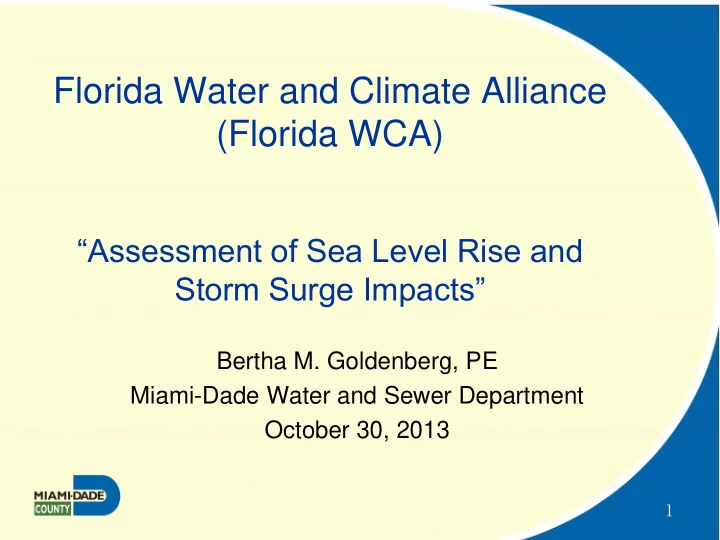

Florida Water and Climate Alliance (Florida WCA) “Assessment of Sea Level Rise and Storm Surge Impacts” Bertha M. Goldenberg, PE Miami-Dade Water and Sewer Department October 30, 2013 1
MDWASD Overview Largest water and sewer utility in Florida, serving more than 2.2 million residents Water System: • 3 large regional and 5 small water treatment plants • Supplying an average of 302 million gallons per day (MGD) 90% of the County’s public water supply Per capita water use 132 gpcd 14 wholesale customers 424,764 retail customers 100 water supply wells 7,918 miles of pipes 38,204 fire hydrants 126,000 valves 2
MDWASD Overview (continued) Wastewater System: • 3 wastewater treatment plants • 2 ocean outfalls and 21 deep injection wells • Collecting, treating, and disposing 307 MGD 342,539 retail customers 13 wholesale customers 6,277 miles of mains and laterals 1,042 sewer pumps stations Reusing 10.2 MGD 3
& Wellfields Northwest Miami Springs Wellfield Wellfields Water & West & Wellfield Wellfield Wastewater Snapper Creek Wellfield South West Wellfield Treatment Facilities & Wellfield & Wellfield & Wellfield & Wellfield Wellfields & Wellfield 4
Integrated Master Plan (Water, Wastewater, & Reclaimed Water) • Updated demand projections to 2035 • Alternative water supply (including reclaimed water) • Ocean Outfall Compliance Plan (June 2013) ( no ocean discharge after 2025) • New wastewater treatment plant in the West • Infrastructure improvements • Redundancy analysis • Energy savings projects • Climate Change impacts 5
Climate Change References • Miami-Dade County GreenPrint: Miami-Dade County Climate Change Advisory Task Force The Mayor’s Sustainability Advisory Board • Southeast Florida Regional Climate Action Plan • EPA’s Climate Ready Water Utilities 6
Assumptions on Climate Change Impacts • 3 ft SLR by 2075 • Saltwater intrusion in water supply wellfields • Increased flooding and infiltration and inflow • Impacts from storm surges on coastal facilities • Drought conditions 7
Tools to Assess Climate Change Impacts • Integrated surface/groundwater model for Biscayne aquifer • Sea Level Rise NOAA Viewer • Storm surge assessment for coastal facilities (preliminary assessment by Hazen and Sawyer, Feb 2013) 8
Sea Level Rise NOAA Viewer http://www.csc.noaa.gov/slr/viewer/# 9
Previous Experience with Storm Surge Hurricane Andrew, August 1992: • 16 ft. storm surge • 140 mph winds • SDWWTP Impacted (12.5 ft surge), back in service in approximately 30 days 10
Coastal Storm Tide Evaluation Coastal Storm Tide 2030 High/2060 Surge Surge High Category Current 2030 Low Low 2060 High 2075 High Range Value Tide (no SLR) (0.25 ft SLR) (0.67 ft SLR) (2 ft SLR) (3 ft SLR) 1 - Minimal 4 - 5 feet 4.5 2.5 7 7.25 7.67 9 10 2 - Moderate 6 - 8 feet 7 2.5 9.5 9.75 10.17 11.5 12.5 3 - Extensive 9 - 12 feet 10.5 2.5 13 13.25 13.67 15 16 4 - Extreme 13 - 18 feet 15.5 2.5 18 18.25 18.67 20 21 5 - Catastrophic > 18 feet 16.9 2.5 19.4 19.65 20.07 21.4 22.4 Notes: 1) Storm categories are based on wind speed and central pressure - surge is estimated 2) Hurricane Andrew (Category 5 storm) resulted in a measured surge of 16.9 feet 11
Storm Surge Analysis 12
Cost Estimates • Full Plant Replacement - $7.5 billion • Total estimated loss (electrical, instruments & controls) from storm - $1.7 billion (23 %) • Hardening of facilities (partial walls, flood logs, watertight doors) - $20 million 13
Existing Adaptation and Mitigation Measures • Water conservation • Emergency backup power • Standby pumps in all pump stations • SCADA at all major plants, pump stations w/malfunction alarms • 24/7 Emergency Call Center • Parallel trains at all wastewater treatment plants • Large inventory of portable power generators, piping, valves, and fittings • Contracts with construction firms for emergency repairs • New design criteria (higher elevation) 14
Next Steps 1. Refine Storm Tide Criteria 2. Perform more detailed asset analysis 3. Evaluate mitigation alternatives 4. Continue hardening program 5. Develop design criteria for new development 15
Miami-Dade Water and Sewer Department: http://www.miamidade.gov/water Water Conservation Program: http://www.miamidade.gov/waterconservation Ocean Outfall Compliance Plan http://www.miamidade.gov/water Bertha M. Goldenberg, PE bmg@miamidade.gov (786) 552-8120 16
Recommend
More recommend